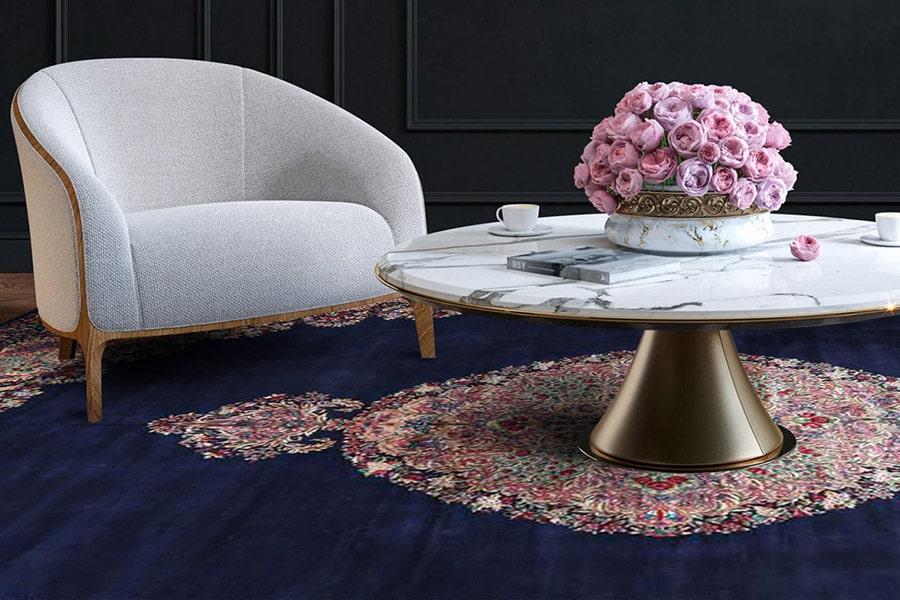From the beginning of recorded history, Kerman has been mentioned under the name of Aratta by Sumerians. They described Aratta as a wealthy land full of precious stones and great artisans that are hard to reach. A land by the name of Inanna comes from the goddess of love, desire, and beauty. This article tells you about the most genuine form of that epic beauty, the Kerman rug.


Where Is Kerman?
The Jiroft-culture remains in the Kerman province tells about a wealthy early Bronze Age civilization. It is between Mesopotamia and the Indus Valley Civilizations.
Kerman kept thriving under the name of Carmania in more clear parts of ancient history as an Achaemenid state. And, also continued its presence through history till now in modern Persian. Kerman, known as the land of rich mines, exquisite crafts, and great rug artisans. Plus, it’s the “Home to the goddess of beauty” who walks on an excellent Kerman rug.
For centuries, the city of Kerman had been a center for shawl weaving. The Safavid Kings of Persia had established some of their royal rug workshops in Kerman. What has remained from the 17th and 18th centuries are today’s most celebrated pieces of the so-called Islamic Arts. Plus, these were collected by museums and auctions, including the two first record-breakers of the category.
In the 19th century, Kerman rug weavers shifted from shawls to rugs and made a turning point in Persian rug history.

Technical Aspects and Structure of The Kerman Rug
Dissimilar to their neighbors, weavers of Karaja make single-weft carpets. If you see a double-weft piece with a Karaja design, that rug would be Karadagh or Qaradagh. And, this means it comes from Azerbaijan.
Today, the Kerman Persian rug primarily comes from the urban workshops in Kerman and towns around it. Kerman knotting style is asymmetrical (Persian) and triple-weft. The most delicate pieces’ knot count reaches 510,000/m2. Additionally, warp and weft consist of cotton, but the pile is woolen.
Antique Kerman rug had the advantage of Kork (also known as Kerman wool), a unique Iranian textile raw material. It is a fine and thin but not fragile hair goat herders shear off a goat breed native to Kerman. Shearing must be in spring, and just the soft hair of inner layers is gathered as kork.
For centuries, rug artisans used kork for warm shawls and fine courtly rugs. During the 19th century, with increased demand for Kerman rug, it became an important raw material for fine-woven Kerman Persian rug. Kork allowed Kerman rug weavers to apply tiny curvilinear patterns in their detailed designs without losing the needed strength.


Dyeing and Painting of The Kerman Rug
Kerman’s master dyers and painters have a vital role in establishing the fame Kerman rug gained. Their wavering colors touch the viewer’s soul deeply. Indigo, cochineal, walnut, weld, pomegranate, vine leaves, straw, and henna are some natural dye materials of the Kerman rug.
To obtain the desired shade, rug artisans dye the wool before spinning; they get Kerman’s reddish tones mainly from cochineal. And, this is what they also use in Heriz or other western parts of Iran.


Designs and Patterns
Master designers of Kerman are the da Vincis and Michelangelos of the Orient. They were the very first rug designers who put their signatures on rugs, celebrating their creativity.
They have influenced not only other Persian rug weavers (such as designers from Yazd, Isfahan, and Khorassan). But, this also includes Indians, Pakistanis, Afghans, and Romanians. Most of the basic Persian rug designs have their Kerman interpretations. Some of them are originally from Kerman, like vase designs. Repeating patterned designs are favored. Both central and all-over medallion designs are the latter primarily for western markets.


Khazai Rugs takes pride in its mesmerizing Kerman rugs, hand-picked directly from the local rug artisans. The selection of Oriental Rugs that we have gathered from all over the world is offered at the lowest price. That is not because we sell low-quality rugs. Rather, it’s because we have developed a unique business model that has removed all the go-betweens. In other words, we get directly in contact with the rug producers and get the rugs from them. Thus, it’s how we lower the final price without any influence on the rug’s quality.
If Kerman rug has gained your interest, head over to our Louisville, KY Rug Store or website now. There you can explore them more in detail. With our On-Approval policy, you can try these rugs in your home to make up your mind in comfort and Free of Charge. Our team will gladly deliver the rugs to your home, and you wouldn’t even have to lift a finger.


